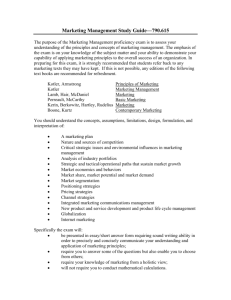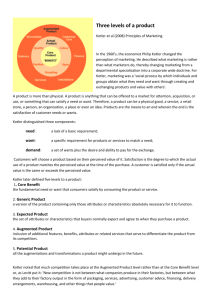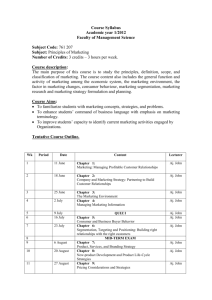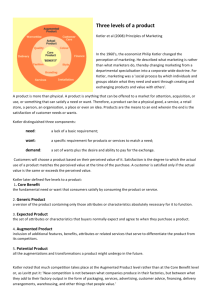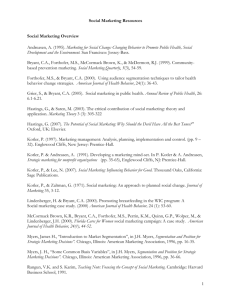Ch. 4 Understanding Target Audience Behavior
advertisement
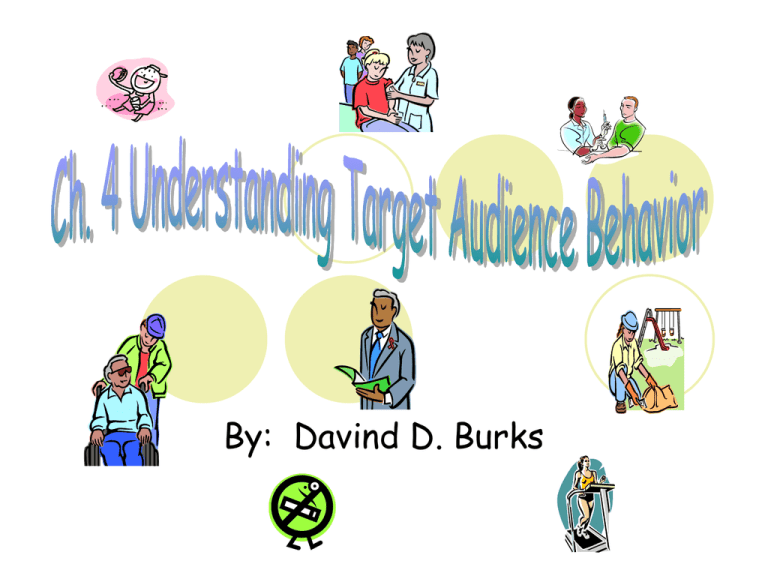
By: Davind D. Burks To INFLUENCE Behavior Changing ideas and thoughts is attempted primarily, but ultimately the behavior is the desired target of change. A mother can be convinced that abusing her child is wrong and possibly fatal, but will she be able to change her behavior when the baby will not stop crying? Andreasen & Kotler, 91 B enefits C osts O thers S elf-Efficacy Benefits and costs are the main focus of marketing: Consumers must give up something (cost) to get something (benefit). Because costs in non-profit marketing can be uncomfortable (giving blood, quit smoking) marketers have to make benefits as appealing as possible. This is not easy! Others (family, peers) can influence marketing in a positive or negative way through social pressure. Ex: giving blood because your mother is going to give as well Andreasen & Kotler, 91-92 B enefits C osts O thers S elf-Efficacy Self-Efficacy can play a part in behavior even when all other factors (benefits, costs, others) are in sync. One has to believe that he/she can change their behavior An overweight person knows that exercise will benefit them for a cost of only 20 min. three times a week. Even with family support, the individual must believe in their ability to commit to change! Andreasen & Kotler, 92 The greatest challenge marketers face is figuring out how to make the benefits greatly outweigh the costs! A simple formula: Benefits of customer= cost to marketer Cost of customer= benefit to marketer The exchange role is very essential Andreasen & Kotler, 93 Two Party or Multiple Party Exchanges Multiple Exchanges: occurs in 1 of 4 ways: Allied with the customer: i.e. family members Allied with the marketer: i.e. advertising agency Independent (but needed to assist operation): i.e. credit card company Independent (but attempting to influence operation): i.e. a church representative advocating abstinence Andreasen & Kotler, 93 Continuing Transactions: those involved must execute their behavior continually per exchange arrangement (i.e. avoiding teen pregnancy) Fixed Duration Transactions: those involved execute their behavior once (i.e. giving blood) Most common on non-profit marketing Reinforcement is the key to fixed duration success Andreasen & Kotler, 93-94 **Understanding consumer behavior is vital for the success of the organization. Management decisions where understanding consumer behavior is key: Segmentation: categorizing consumers into groups according to similarities Marketing Mix: pricing costs and benefits, how to promote pricing conclusion, how to distribute the end results in a convenient and attainable manner for consumers Strategic Allocation: how much money and resources to use for desired project Timing: when to employ the final marketing strategy Andreasen & Kotler, 94 4 levels to make management decisions easier: Descriptive understanding: profile characteristic (age, sex, occupation) or complexly categorize (social class, family life cycle) Understanding of associations: how some behaviors/characteristics are linked with others at a given time Understanding of causation: goes beyond linking behaviors to understanding what causes them (is it a factor that can be controlled by the manager?) Ability to explain causation: now, goes beyond what causes behaviors to why it occurs! **Complexity grows with each level. This is not easy!! Only experience, time, and careful research leads to successful management decisions. Andreasen & Kotler, 94-95 Consumers must make the decision to engage in behaviors influenced by marketers. There are 2 factors that play a part in consumer action. **See Table 4-1 on p. 96 Low-involvement: simple exchanges such as signing a petition that do not involve complex decision making High-involvement: contingent upon 1 or more of the subsequent: Behavior mirrors self-image Monetary/personal costs of undesirable behavior is favored Personal/social danger of making a bad move is feared The pressures from “others” (remember?) to behave or not to behave in a particular way is strong, making impulse to conform stronger Andreasen & Kotler, 95-96 Behaviors which are being performed for the very first time are those which cause consumers to go into complex decision making mode. The behaviors are also usually of high involvement and occurring over time. According to research, more successful marketing can come from the creation of stages beginning with the stage the current target audience is in. The goal should be transitioning the audience to the next stage, making the change more attainable. Andreasen & Kotler, 97 Precontemplation: an audience who has just began to consider a marketer targeted behavior Never heard about benefits of behavior Heard of behavior yet not attracted (i.e. against religion, inappropriate) 2 Stages of Contemplation: Contemplation: audience is already considering targeted behavior Weighing costs and benefits Thinking of the opinion of “others” Thinking of their ability to perform behavior **Most marketing begins here Andreasen & Kotler, 97-98 Early: thoughts of behavior just beginning • Focus on benefits and costs (mostly benefits; determines moving to next stage) Late: considering behavior more • Focus on costs, other, ability Preparation and Action: audience has carefully thought out the behavior and action soon follows. Action may be prolonged by self-doubt, opportunity, or because they need a boost in the forward direction Maintenance: reinforcement comes into play due to the marketers goal of long term behavior compliance. Keeping audience engaged is the key Andreasen & Kotler, 98 Precontemplators: Arouse audience senses through awareness, knowledge, and interest Contemplators: Early: emphasize personal (not societal) benefits Late: emphasize the reduction of costs and social pressure Preparation and Action: Boost self-esteem, create an abundance opportunities Maintenance: Generate rewards, make behavior continuance simple, focus social pressure on the good behavior Andreasen & Kotler, 99 In the world of non-profit marketing, where long term behavior change is the most common goal, understanding consumer behavior and how to apply stages to easily reach their goals are very essential steps to success.
